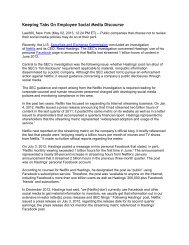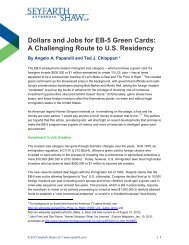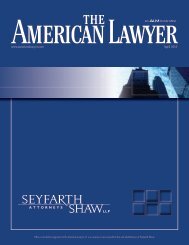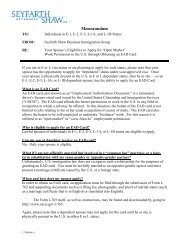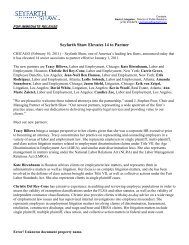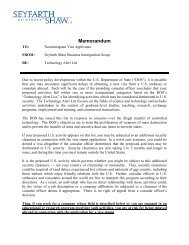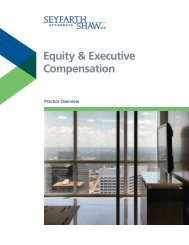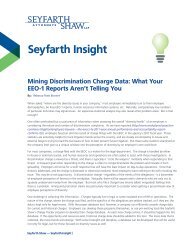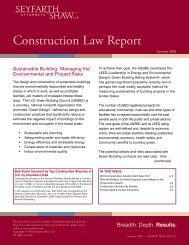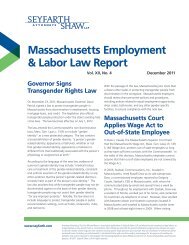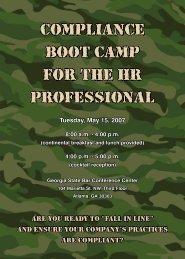Litigating California Wage & Hour and Labor Code Class Actions
Litigating California Wage & Hour and Labor Code Class Actions
Litigating California Wage & Hour and Labor Code Class Actions
Create successful ePaper yourself
Turn your PDF publications into a flip-book with our unique Google optimized e-Paper software.
Before suing, an aggrieved employee now must exhaust an administrative<br />
procedure that involves providing written notice of the particular <strong>Labor</strong> <strong>Code</strong><br />
violation to the employer <strong>and</strong> the <strong>Labor</strong> Commissioner, for possible investigation<br />
before filing suit. 248 Failure to exhaust this administrative remedy within one year of<br />
the violation bars the suit. 249<br />
The <strong>Labor</strong> Commissioner now has authority to promulgate regulations to<br />
implement the statute (although they have yet to attempt to do so).<br />
Although the 2004 reforms to PAGA may seem modest, they appear to have had the effect<br />
of substantially reducing the attractiveness of these kind of lawsuits. PAGA claims are not<br />
typically asserted by themselves, but rather are added to st<strong>and</strong>ard wage <strong>and</strong> hour class<br />
actions, typically for bargaining leverage.<br />
B. Scope of the “Civil Penalty” Provisions<br />
With the creation of the administrative remedy requirement before an employee could seek<br />
penalties under PAGA, the question arose whether this administrative requirement applied<br />
to all statutes covered by PAGA. More specifically, Section 2699.3 sets forth a long list of<br />
particular statutes that are purportedly subject to the administrative remedy. Included on<br />
this list are several statutes that provided for penalties recoverable by individual employees<br />
even before the passage of PAGA (e.g., <strong>Labor</strong> <strong>Code</strong> Section 203, which provides for<br />
waiting time penalties where employers willfully fail to pay terminating employees all wages<br />
owed to them). Defendants began to argue that no employee could sue to recover<br />
penalties under any statute listed in Section 2699.3 without first exhausting administrative<br />
remedies.<br />
In November 2004, the Second District Court of Appeal issued Caliber Bodyworks v.<br />
Superior Court, 250 which clarified the scope of the administrative remedy exhaustion<br />
requirement in PAGA. The court held that the administrative remedy requirement applied<br />
only to actions seeking to recover a “civil penalty,” which the court distinguished from<br />
actions that could be advanced by individuals to recover “statutory penalties,” such as<br />
<strong>Labor</strong> <strong>Code</strong> Section 203. In short, the court held that if a plaintiff seeks to recover penalties<br />
that were available under a statute <strong>and</strong> recoverable by an individual prior to PAGA’s<br />
248<br />
249<br />
250<br />
Lab. <strong>Code</strong> §§ 2699(a), 2699(g)(1), <strong>and</strong> 2699.3.<br />
Moreno, 2007 U.S. Dist. LEXIS 43873, at *4-10 (N.D. Cal. June 5, 2007) (employee who filed lawsuit within one year,<br />
but failed to exhaust administrative remedies until more than one year after leaving employment was time-barred from<br />
asserting PAGA claims).<br />
134 Cal. App. 4th 365 (2005).<br />
Seyfarth Shaw LLP | www.seyfarth.com <strong>Litigating</strong> <strong>California</strong> <strong>Wage</strong> & <strong>Hour</strong> <strong>Class</strong> <strong>Actions</strong> (12th Edition) 58



